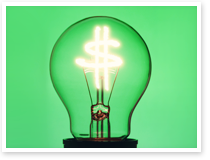Sheryl Carter, Co-Director, Energy Program, San Francisco
A new report by utility and finance experts contains positive news for the environment, our air and our (and our utilities’) pocketbooks — the economics of electric power resources have made zero-emissions energy efficiency and renewable energy technologies the most financially attractive options to meet the nation’s future energy demands.
The report by the nonprofit organization Ceres, entitled “Practicing Risk-Aware Electricity Regulation: 2014 Update,” says energy efficiency, distributed (onsite) energy, and renewable energy (whose costs, in some cases, have come down dramatically since 2012) are enticing investments for utilities because they bring lower risks and will cost less than traditional energy sources used to generate electricity.
And almost without exception, the report says the investments that could cause the most financial harm for utilities, ratepayers, and investors are large base-load fossil fuel and nuclear plants, which are riskier and more expensive.
“The report’s risk profiles make clear that energy efficiency is the cheapest, safest investment by far, followed by wind and solar energy technologies whose costs have dropped dramatically the past two years,” says Ceres President Mindy Lubber.
We already knew that energy efficiency — aka smarter use of energy — is the cheapest, most abundant investment out there, as I noted recently in discussing the International Energy Agency (IEA) Energy Efficiency Market Report 2014 that demonstrated the global savings from energy efficiency are greater than the output from any other single fuel source — including coal, oil, nuclear, and gas. Meanwhile, the first national limits on power plant carbon pollution will increase energy efficiency, which will reduce the cost of compliance.
But as Ronald Binz, one of the authors of the new Ceres report, says, “the dramatic decline in the costs of renewable energy, especially utility-scale solar,” represents a major development that could have far-reaching consequences.
The changing economic landscape combined with the pending EPA power plant standards to reduce carbon pollution, does not mean change will come overnight or that there will be any let-up by the supporters of coal and nuclear power. But the trend line is positive and strongly suggests that the old ways of doing business for utilities and state regulators are no longer as viable as they once were, and in fact carry significant financial risk.
The latest findings by Ceres, a nonprofit organization that seeks to mobilize business an investor leaders on climate change, reaffirms the conclusions and recommendations in its 2012 report, “Practicing Risk-Aware Electricity Regulation: What Every State Regulator Needs to Know,” that discussed the aging power plant fleets, evolving technologies and regulations for climate change, and the changing nature of the risks that these challenges present for utilities, customers and shareholders.
The latest findings
In examining the conditions facing today’s electric power industry, the new report cites a number of salient facts and reached some important conclusions that should be heeded by the utility industry as its plans how to address the nation’s energy needs, including:
- There is a clear and durable imperative for clean energy in the United States, driven by advancing technology, federal air quality rules, and the lower cost and risk profile of renewable and demand-side energy resources. Renewable energy technology costs have fallen sharply, closing the cost gap between renewable resources and traditional fossil fuel resources. Solar photovoltaic energy costs, in particular, have declined precipitously in recent years while wind and solar costs are expected to continue to fall through at least 2020, a characteristic not shared by other generation technologies.
- Utility business models conversations are shifting from a simple “cost of service” approach to consideration of one that expands utility service offerings and capabilities in light of carbon reduction goals, grid resilience needs, and customer engagement imperatives. This transformation is already happening to a degree that seemed unthinkable just a few years ago.
- Distributed energy resources — that is smaller power sources like demand response (when customers alter their electricity use at certain times of the day), storage, and distributed generation, that can be aggregated to provide energy necessary to meet regular demand — will play an increasingly important role in the 21st century electricity system. As states grapple with this reality, they must begin to plan for a much more complicated system that includes new technologies and varied sources of energy.
The bottom line, as the report clearly suggests, is that the trend toward low-carbon energy resources, including energy efficiency and renewable energy, is unmistakable. When we don’t need to generate as much electricity and/or use zero-emissions resources, we reduce the amount of climate-altering pollution belching into our air and harming our health. In short, as the report notes, “There is a clear and durable imperative for clean energy in the U.S.” that is being driven by new technologies, more favorable economics, stricter federal air quality rules, and consumer demand.







